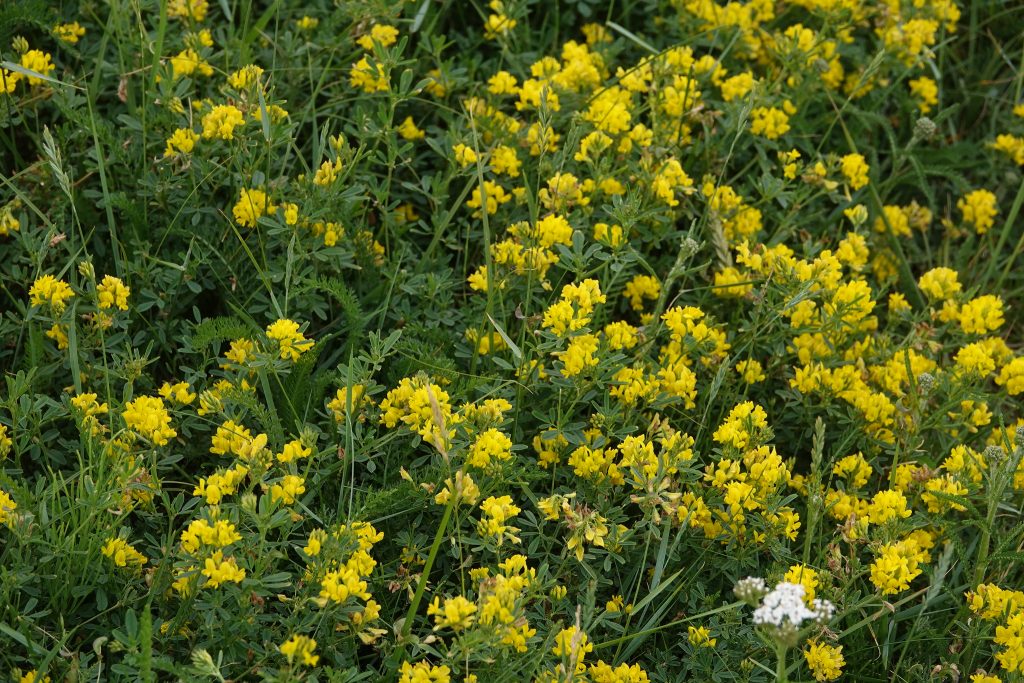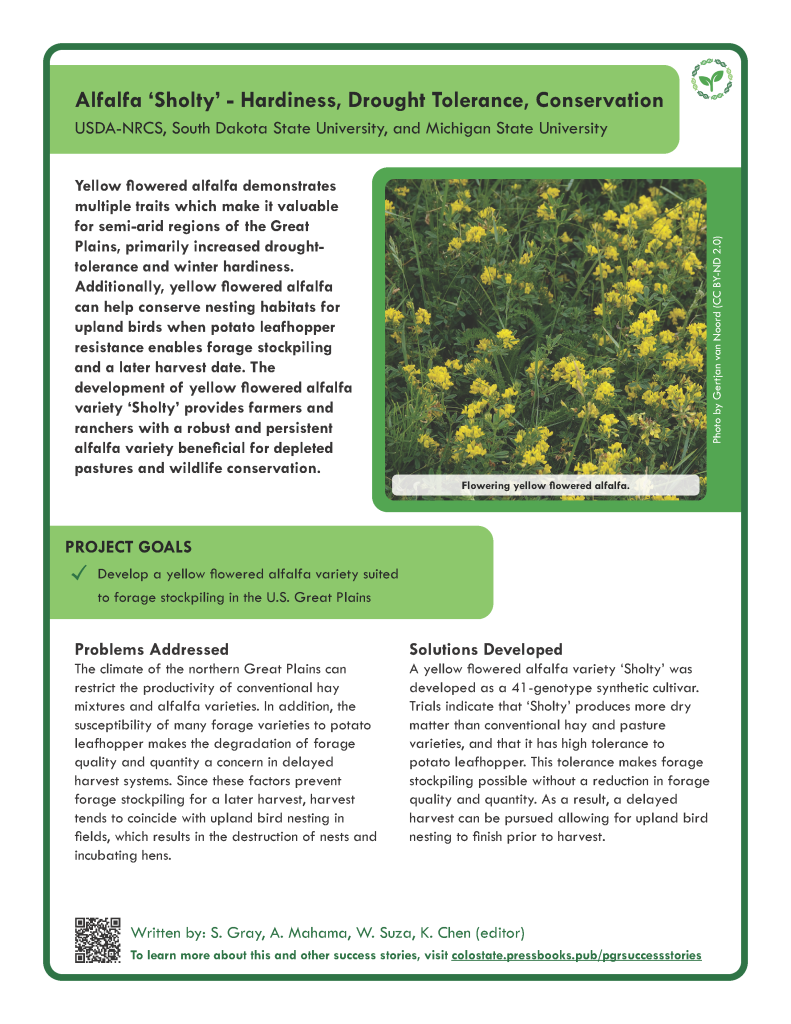Forage
Alfalfa ‘Sholty’ – Hardiness, Drought Tolerance, Conservation
DEVELOPMENT OF ‘SHOLTY’ YELLOW FLOWERED ALFALFA (MEDICAGO FALCATA) VARIETY FOR SEMI-ARID GREAT PLAINS
Stephen Gray; Anthony Mahama; and Walter Suza
Department of Agronomy, Iowa State University, Agronomy Hall 716 Farm House Ln, Ames, Iowa 50011.
Corresponding author: sjgray4@iastate.edu
OUTLINE
1. SUMMARY

Yellow flowered alfalfa (M. falcata) demonstrates multiple traits that make it valuable for semi-arid United States Great Plain regions, primarily improved drought-tolerance and winter hardiness. Additionally, yellow flowered alfalfa can help conserve nesting habitats for upland birds when forage stockpiling allows for a later harvest date. The development of yellow flowered alfalfa variety ‘Sholty’, provides farmers and ranchers with a robust and persistent alfalfa variety that is beneficial for depleted pastures and wildlife conservation.
The goal was to develop a yellow flowered alfalfa variety with prolonged flowering, early vigor, and resistance to potato leafhopper to make the variety suitable for a one-cut forage system where forage stockpiling is necessary.
Download a printable fact sheet by clicking the image below.
2. PROBLEMS ADDRESSED
The cold and dry environment of the semi-arid regions of the Great Plains necessitate the development of drought-tolerant and winter hardy forage varieties. In 1906, while traveling throughout northern Europe and Asia, USDA Plant Explorer Niels Ebbesen Hansen noticed that yellow flowered alfalfa demonstrates robust drought tolerance, winter hardiness, and palatability to livestock (Boe et al., 1998; 2020). Hansen’s introduction of yellow flowered alfalfa germplasm to the United States was the catalyst for yellow flowered alfalfa breeding to solve production limitations in semi-arid regions of the Great Plains.
Additionally, many areas devoted to forage production in the Great Plains serve as ideal nesting habitats for upland bird species. However, it is often the case that the first harvest of alfalfa coincides with upland bird nesting, which can result in the destruction of nests and incubating hens (Trautman, 1982). One solution to this problem is forage stockpiling, which allows forage biomass to accumulate for a longer period of time and is then harvested at a later date. In order to successfully implement forage stockpiling, a yellow flowered alfalfa variety must demonstrate robust resistance to potato leafhopper, a pest that causes a decrease of forage quality later in the growing season.
3. SOLUTIONS DEVELOPED

The development of ‘Sholty’ was based on selection criteria for vigor, tolerance to potato leafhopper yellowing, indeterminate flowering, and semi-erect growth (Boe et al., 2020). Additionally, field trials of ‘Sholty’ demonstrate that it produces more forage under drought than conventional hay and pasture mixtures (Boe et al., 2020). As a result, ‘Sholty’ provides farmers with a robust and persistent yellow flowered alfalfa variety that is suitable for single harvest systems. Moreover, ‘Sholty’s high tolerance to potato leafhopper yellowing ensures that forages can be stockpiled in fields for delayed harvest without a reduction in forage quality (USDA, 2015). The ability to stockpile forage for a delayed harvest has a beneficial impact on upland bird species conservation.
Collaborators involved in developing solution:
- South Dakota Agricultural Experiment Station, South Dakota State University, South Dakota, USA
- Michigan Agricultural Experiment Station, Michigan State University, Michigan, USA
- USDA-NRCS Bismarck Plant Materials Center, Bismarck, North Dakota, USA
- USDA-NRCS Rose Lake Plant Materials Center, Lansing, Michigan, USA
4. IMPACT
‘Sholty’ has demonstrated promise in trials when planted into cool-season grass in Highmore and Brookings, South Dakota, where it yielded more dry matter than conventional pasture varieties (USDA, 2015). Additionally, ‘Sholty’ outperformed other yellow flowered alfalfa varieties ‘Don’ and ‘Yellowhead’ in Brookings, South Dakota trials (USDA, 2015). Moreover, the forage stockpiling capabilities of ‘Sholty’ serve as a potential benefit to upland bird conservation as it has been predicted that normal first cuttings of alfalfa could destroy up to 86% of nests (Trautman, 1982).
5. GERMPLASM
‘Sholty’ is a 41-genotype synthetic cultivar derived from 13 germplasm sources. Genotypes are from the following germplasm sources: 7 Plant introductions, 4 experimental collections from rangeland populations in South Dakota, and 2 cultivars (USDA, 2015). The genotype information is listed below:
Seven plant introductions (PI 231731, PI 251689, PI 315476, PI 325383, PI 325406, PI 325408, PI 384507), four experimental collections (E 82M8S2, E 82M165, E KSE, E SDMF-1), and two cultivars (Anik, Kuban).
6. REFERENCES
USDA. 2015. Release Brochure for ‘Sholty’ yellow-flowered alfalfa (Medicago sativa subsp. falcata). USDA-Natural Resources Conservation Service, Plant Materials Center, Bismarck, North Dakota 58504.
Boe A, Kephart KD, Berdahl JD, Peel MD, Brummer EC, Xu L, Wu Y. 2020. Breeding alfalfa for semiarid regions in the Northern Great Plains : History and additional genetic evaluations of novel germplasm. Agronomy 10:1686. https://doi.org/10.3390/agronomy10111686
Boe A, Bortnem R, Higgins KF, Kruse AD. 1998. Breeding yellow-flowered alfalfa for combined wildlife habitat and forage purposes. Bulletins, Paper 730, South Dakota State University, Brookings, SD.
Trautman CG. 1982. History, ecology and management of the ring-necked pheasant in South Dakota. South Dakota Game, Fish & Parks Dept, Pierre, SD.
7. CHAPTER INFORMATION
Citation: Gray S, Mahama A, Suza W. 2022. Alfalfa ‘Sholty’ – Hardiness, Drought Tolerance, Conservation. In: Volk GM, Chen K, Byrne P (Eds.) Plant Genetic Resources: Success Stories. Fort Collins, Colorado: Colorado State University. Date accessed. Available from https://colostate.pressbooks.pub/pgrsuccessstories/chapter/alfalfa-sholty-hardiness-drought-tolerance-conservation/
Content originally submitted: March 30, 2022
USDA is an equal opportunity provider, employer, and lender. Mention of trade names or commercial products in this article is solely for the purpose of providing specific information and does not imply recommendation or endorsement by the U.S. Department of Agriculture.


